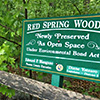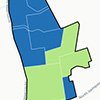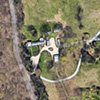How Nassau’s open-space purchases benefited political insiders
The county's Environmental Bond Acts have long been acclaimed for preserving land, but a number of the purchases were from people with ties to county politics, the property selection process or both.
The day after Nassau County acquired nine acres of Glen Cove woods, neighbors threw a party.
A bluegrass band played, guests sipped drinks, and Gordon Allan, who led a local preservation group’s push to spare the land from development, stood behind his family’s home along the old-growth forest and gave certificates of appreciation to elected officials.
Leading up to the $4 million purchase of Red Spring Woods in September 2006, Allan emphasized its ecological benefit.
Three years later, the transaction paved the way for him to benefit financially as well.
Using the same fund, then-County Executive Thomas Suozzi’s administration paid $600,000 for 1.77 acres of the adjoining Allan family property, $50,000 more than the county’s final appraisal estimated it was worth. In disclosure forms filed with the contract, Allan, who owned the land under a trust with his two brothers, didn’t reveal that he served at the time as a special assistant in the county personnel office, a $55,000-a-year, politically appointed job.
The deal was among several made with $100 million apportioned from Nassau’s landmark Environmental Bond Acts of 2004 and 2006 that benefited political insiders as well as wildlife and water quality, a Newsday investigation has found.
The program’s achievements have long been proclaimed: purchases that saved some of the county’s last remaining working farms, kept open an old equestrian center, and greatly expanded the majestic Old Westbury Gardens preserve and museum.
But among the bond act acquisitions — closed between 2006 and 2012 — almost $30 million was paid to people with ties to county politics, the property selection process, or both.
Records show these payments, which secured a quarter of the program’s nearly 300 preserved acres, went to four- or five-figure campaign contributors to Suozzi, a Democrat, or his Republican successor, Edward Mangano; county patronage employees or those close to them; and major financial backers of the advocacy group that largely bankrolled the bond referendums and had influence on which sites were recommended.
They leave questions about whether the money could have been better used to realize a never-achieved promise of enhanced public access to some of the sites and whether other recommended properties held by less-connected people could have been bought instead.
The deals involving people with ties to the process were frequent enough that, in 2014, after Suozzi had given way to Mangano, County Planning Commission Chairman Jeffrey Greenfield alluded to them in a reply to a query from Democratic County Legis. Kevan Abrahams. He had objected to a widely criticized and eventually discarded Mangano proposal to use open space funds to buy his deputy parks commissioner’s nursery lot, then in foreclosure proceedings.
Greenfield reminded Abrahams that during the Suozzi administration he’d voted for numerous land acquisitions for “friends and family.”
Abrahams, who remembers being puzzled, said Greenfield’s letter prompted him and a few other Democratic legislators to learn, for the first time, about the previously undisclosed connections in some Suozzi-era bond act deals – something GOP lawmakers had whispered about for years.
“We looked at each other, like, ‘What is he talking about?'” Abrahams recalled. Then, he said, “We figured it out.”
In at least three cases, Newsday found that the county paid above its own market-value assessment of the land, or what was estimated in appraisals it commissioned. At least five of the properties were not under imminent development pressure, which was one of the criteria for prioritizing buys, or could not be developed without significant roadblocks.
As taxpayers continue to pay down the borrowing for the purchases — the environmental bond portion of this year’s county tax levy is $7.7 million, or $8 on the average homeowner’s tax bill — the level of public access promised for many of the sites was never realized. Several are fenced off. For others, signage and promotion are inconsistent, parking isn’t always available and walking trails and other amenities weren’t installed.
“You have to kind of be ‘in the know’ a little bit of the local landscape to get to these spots,” said Brian Schneider, Nassau’s deputy county executive of parks and public works.
The overwhelming proportion of land acquired was on Nassau’s North Shore, primarily in affluent Oyster Bay villages with expansive estates. Some of the acquisitions, removed from the tax rolls, blend almost seamlessly into the sellers’ remaining property and effectively continue to be extensions of them.
And in those cases, the landowners not only got paid market value prices for what they sold to the public, they reduced their property tax burden because their retained private property got smaller.
“I thought it really benefited, mostly, the rich people on the North Shore,” said Victor Consiglio, a former Massapequa resident who was active in South Shore waterway cleanups and served on one of the advisory committees that recommended open space buys. “They’ll have all the access to that property just as if they never sold it, except now they pay less taxes.”
Defenders of the program said politics was never a consideration and that questions of access and geographic equity were always secondary to the mission of preventing development on the county’s last swaths of remaining untouched land, much of which had sensitive ponds, brooks or streams and was in a state-designated Special Groundwater Protection Area that encompassed northern Oyster Bay.
“We understand that trees help recharge our groundwater, they help clean our air. Wetlands clean the water as it leaves the land, before it gets into our beaches and bays,” said Lisa Ott, president and CEO of the North Shore Land Alliance, the Oyster Bay nonprofit that lobbied for the bond programs and had significant influence on what was purchased. “So what we have left is really precious.”
Land Alliance staff, board members and advisers involved in the bond act selection process supported the county spending millions of dollars on land owned by prominent contributors to the nonprofit, including some who gave it at least $10,000 in the years their properties were recommended and purchased.
If the seller also happened to be a political campaign contributor or Land Alliance backer, or have political ties to county government, it was secondary, Ott said, because each site was judged solely on environmental merits.
“These were peripheral details,” she said. “They weren’t even a part of the process.”
Many of the people who volunteered on the committees that reviewed open space nominations said they weren’t presented with those kinds of details to weigh.
“Someone may have known about it, but it wasn’t brought out,” said Gary Carlton, an attorney active in North Woodmere civic matters who served on one of the advisory committees and later ran for local offices as a Democrat.
Suozzi, a Glen Cove resident who served two terms as Nassau County executive, through 2009, when he lost to Mangano — and now represents the 3rd Congressional District — declined to speak in detail for this story. But in a brief interview, he defended the deals executed under his administration as well-vetted by the advisory committees and then widely supported by county lawmakers of both parties.
He also alluded to the properties purchased during his tenure as being bought for prices in the general range of assessments and appraisals, contrasting it with an acquisition under Mangano in which a political ally, Gary Melius, received more than double what his land had been valued under Suozzi.
An attorney for Mangano, who left office at the end of 2017, did not return a request for comment.
“These projects, from over a decade ago, were unanimously approved by the legislature in a bipartisan fashion. They went through a rigorous process with an independent committee of respected environmentalists,” Suozzi said. “In each instance, the amount paid for the properties were fair market value. I don’t know if the same can be said of projects that were done after my administration.”
But after being told that many people involved in the review process said they didn’t know some of the sellers’ connections, Suozzi acknowledged that some aspects could have been handled differently.
“Hearing all these details now, I remain very proud of this program and what was accomplished,” he said. “But there could have been more disclosure and transparency.”
Allan, however, insisted that in his particular transaction, “everything that was done was completely above board and clean. And it was probably because people knew that this could be misconstrued.”
Push to preserve
Nassau’s environmental bond program was established in 2004, after the Regional Plan Association had detailed how the county, without action, faced the prospect of losing all of its remaining unprotected open space in less than a decade. Preservationists urged Suozzi and the county legislature to back a referendum for the first $50 million in bonds, which passed overwhelmingly — as did another $100 million in 2006.
Of the total $150 million, $50 million was earmarked for park and storm-water improvements and brownfield remediation, projects that would help the central and southern portions of the county reap more program benefits. The rest was used for open space, with priority to farms and expanding existing preserves.
The bond acts required parcels to be recommended for purchase by an advisory committee appointed primarily by the county executive. The committee’s recommendations, based on criteria such as size, development pressure and importance to groundwater supply, were forwarded for votes by the county’s Planning Commission and the Open Space and Parks Advisory Committee, a separate appointed body to review public land buys. The county executive then signed off on selections before presenting them to the county legislature , where they needed approval by at least 13 of the 19 lawmakers.
Nassau’s process was missing some of the safeguards that Suffolk had installed in 2002, in response to controversy. After Suffolk’s real estate director negotiated the purchase of land at twice the appraised price from a business associate, that county began requiring that every transaction receive legislative authorization twice — once before appraisals and negotiations and then again to approve the acquisition.
“That kind of money just creates all kinds of temptations,” said Paul Sabatino, a former Suffolk legislative counsel and deputy county executive who helped write a series of ethics reforms in the county.
Nassau’s legislature, however, didn’t vote to approve the start of each property negotiation — only the borrowing of funds and final contract of sale. A review of transcripts from legislative meetings when acquisitions were approved shows that sellers’ ties to county politicians or the property selection process were never prominently raised.
The Planning Commission and Open Space and Parks Advisory Committee also didn’t focus on these aspects of the deals.
Suozzi appointed the majority of each 12-member advisory committee that, for the respective bond acts, reviewed and ranked nominations. Nominations could come from anywhere in the community but – for land that was ultimately purchased – were primarily made by a small circle of environmentalists, county legislators and the property owners themselves.
The advisory committees were largely the same for the 2004 and 2006 programs. Some were environmentalists, some were civic leaders, but most were also tied to the Democratic Party. In all, 11 of the 17 people who served on one or both advisory committees have been campaign donors to Suozzi, the county Democratic committee or a local Democratic club or candidate, records show.
The committees were chaired by Brian Muellers, a former Democratic county legislator from the county executive’s home base of Glen Cove. Many participants, however, point to the Land Alliance as holding great sway in the discussions. The nonprofit, whose board of trustees was led by Carter Bales and Luis Rinaldini, Manhattan private equity and investment firm founders living in the area’s incorporated villages, formed in 2003 to preserve some of the remaining tracts of open space in the area.
“In a word, Tom and I agreed on the need to protect the environment and the character of the community,” Bales wrote in an email, referring to Suozzi.
Rinaldini, who knew Suozzi from Glen Cove — and was an early supporter of his first county executive run — said in an interview that the Land Alliance saw the bond acts as the most realistic option to quickly preserve sensitive parcels. The Town of Oyster Bay had recently done something similar, and getting approval to dedicate a portion of recurring county tax revenue for open space, as Suffolk County has done for decades, had little support in Albany.
“We were actually pretty vigilant not to have what I would call irreconcilable conflicts,” Rinaldini said about vetting potential sellers. “If someone close to a politician happens to own land [that otherwise met the program’s environmental criteria], that’s fine. But it’s really more, ‘how did that decision get made’ and ‘does it fit?'”
When Suozzi established the first advisory committee in 2005, the Land Alliance was well represented. Besides Ott, it included Ralph Fumante, an alliance board trustee from Oyster Bay Cove who was also chairman of the county Open Space and Parks Advisory Committee, the separate oversight body that later signed off on all recommendations. Also serving with the county bond act advisory committee were alliance advisory board members Katie Schwab, then Suozzi’s deputy planning commissioner, and Neal Lewis, a county planning commission member.
Ott said the large preponderance of purchased land on the North Shore didn’t indicate disproportionate influence but, rather, a disproportionate balance of where remaining open space was: “You can only buy land where it exists,” she said, noting that the largest parcels of South Shore green space were already state or local parks.
The bulk of the $100 million for open space was spent under Suozzi. About $23 million in deals involved sellers who had been Suozzi campaign contributors, had been appointed by him to a government or campaign post or had ties to someone who had, or had been significant backers of the Land Alliance, Newsday found.
Under Mangano, with most of the open space money spent, the county did not convene a new advisory committee. The sole bond-act-funded acquisition initiated under his administration involved an old water utility property in Freeport, owned by Melius, an influential friend of the GOP county executive, which was bought for $6.2 million, more than double what the highest appraisal commissioned by Suozzi’s real estate office had valued it at: $2.7 million.
The Mangano administration had commissioned new appraisals of the land, and they came back at $6.3 million and $6.9 million.
Mangano, a Bethpage resident, also pushed the heavily criticized attempt to have the county buy the old nursery lot owned by Frank Camerlengo, his deputy parks commissioner, in Bethpage.
The Suozzi administration’s deal with Gordon Allan, for land that county appraisers said would be difficult to develop, was one of the last during his administration. It gained legislative approval in December 2008, after the recession had started, and didn’t close until Suozzi’s next-to-last day in office in December 2009.
But it had its origins more than three years earlier.
‘A divine thing’
The nine-acre Red Spring Woods parcel in Glen Cove, about a half-mile from where Suozzi lived, was bought by the county in September 2006, during the first environmental bond act process.
That was largely thanks to Allan, the Suozzi-appointed special assistant in the county personnel office, who had created a resident coalition that joined with the Land Alliance to push officials to preserve the land once they heard it had been acquired by a developer.
The group created a website, had its representatives speak at public meetings, hired a biologist to survey the trees and wildlife on the property and even published a member’s poem (“This lovely place of meditation, which should merit conservation/Is threatened by a builder’s desire for more McMansions, which has raised the ire/of the surrounding community/who say that they all agree/that this is Glen Cove’s last green space/a peaceful, special, hidden place…”)
It all led Al Cirignano, the Bayville-based developer, to abandon his plans to build six homes there and instead sell the land to the county for $4 million, about $500,000 more than he and his partner had paid for it several months earlier, records show.
“They even gave him a little plaque,” Al Cirignano Jr., the late developer’s son, recalled of Allan’s coalition, which also distributed plaques to Suozzi, Glen Cove city officials and environmentalists on the day it held a party to celebrate the county’s acquisition.
Allan’s motivation to save Red Spring Woods, he said, was always his father. The Rev. William Cameron Allan was a well-known Presbyterian minister in Glen Cove who served as chaplain to the city police and fire departments. He died in 1997.
He had cherished the woods behind the family home, so when the first county bond act funding came through, while Allan was looking for a way to stop development on it, Allan said, “I swear it sounds like a divine thing.”
Then came the additional $100 million in bond act funding.
“As soon as I heard,” Allan recalled, “I looked at the sky and said, ‘Dad, you did it again.'”
At the time, his mother, Gail, was living in the house on the family’s 2.6 acres, owned by Gordon Allan and his two brothers under a family trust.
She was looking to move into a retirement community, so Allan said he told her he’d approach the county and ask it to buy the land. Allan proposed a 1.77-acre subdivision for preservation and nominated it upon the second bond act program’s advisory committee convening in early 2007.
“I did nothing except go through the proper channels,” Allan said, noting that his nomination had to be vetted with all of the others to be recommended by the advisory committee.
Nassau’s first commissioned appraisal, in October 2007, valued the vacant land that Allan wanted split from the property at $700,000 but noted that it would be “costly and time consuming” to ever develop a new home there, citing its steep sloping, irregular shape and need for zoning variances. Five months later, in early 2008, a second appraisal valued the land at $550,000, saying “many hurdles” had to be overcome if it would ever meet its “highest and best use” as a residential plot, rather than undevelopable, less valuable vacant land.
No disclosure
Allan and his siblings signed the $600,000 contract of sale with Nassau in August 2008. On his disclosure form filed with the contract — titled “Disclosure of Those Affiliated with Nassau County” — Allan wrote “n/a” to the question of whether he held “any county, town or village public office in Nassau County.”
“If they would have asked ‘do you hold a job in government,’ I would have immediately put yes, because you can’t hide stuff like that,” Allan said.
County legislative committees and the full legislature each approved the purchase unanimously in December 2008, with no mention of Allan’s connections at any of the meetings, transcripts show.
By that point the economy had cratered and the value of all land had decreased. But Suozzi aides told legislators they believed they were getting a “good deal,” citing the first $700,000 appraisal, which at that point was more than a year old.
Then-Legis. Dave Denenberg, who chaired the planning, development and environment committee, asked Suozzi’s deputy real estate director, Sean Rainey, if he felt comfortable with the $600,000 sale price, wondering if the land had devalued even beyond the $550,000 appraised in early 2008.
“I feel comfortable with that number, because it was discounted enough where I don’t think it would make much of a difference,” Rainey replied, according a meeting transcript.
The deal wouldn’t close for another year — Dec. 30, 2009, two months after Glen Cove granted Allan the subdivision he needed to complete the sale.
“It bothers me, but we didn’t know,” said Denenberg — who left office in 2015 after a federal mail fraud conviction related to his private legal work — of voting for the deal without being informed of Allan’s county job. “We were trying to prevent that stuff all along, but if the people who knew didn’t disclose it, that was a problem.”
Allan, who lost his county position on the first day of the Mangano administration, now lives in the family home.
He said neither he nor Suozzi did anything wrong because he didn’t directly deal with Suozzi in the process, while citing the advisory committee as legitimately choosing his property for environmental reasons.
Suozzi declined to comment on specific bond act transactions.
“Tom is no fool,” Allan said. “Mr. Suozzi realized that when you spend this kind of money, you have to have checks and balances in place. Otherwise corruption will be rampant.”
Do you have information on any other sites purchased under Nassau’s environmental bond acts that remain obscured, hidden or lack sufficient public access? Contact Paul LaRocco at (631) 843-2736 or paul.larocco@newsday.com.

 Overview:
Overview: Map:
Map: Part 1:
Part 1: Part 2:
Part 2: Part 3:
Part 3:


 Video:
Video: